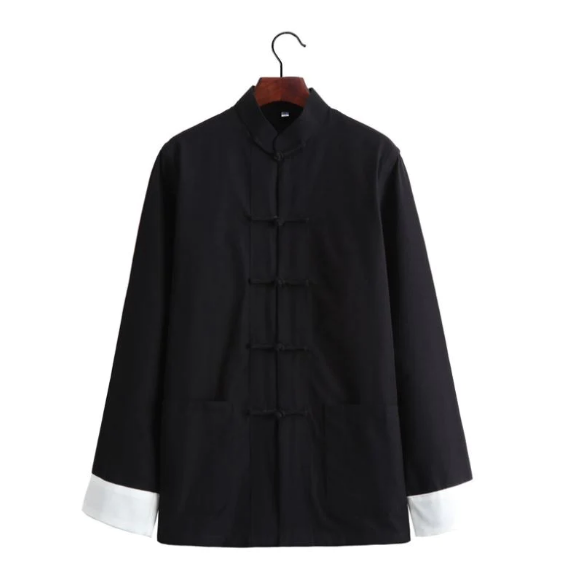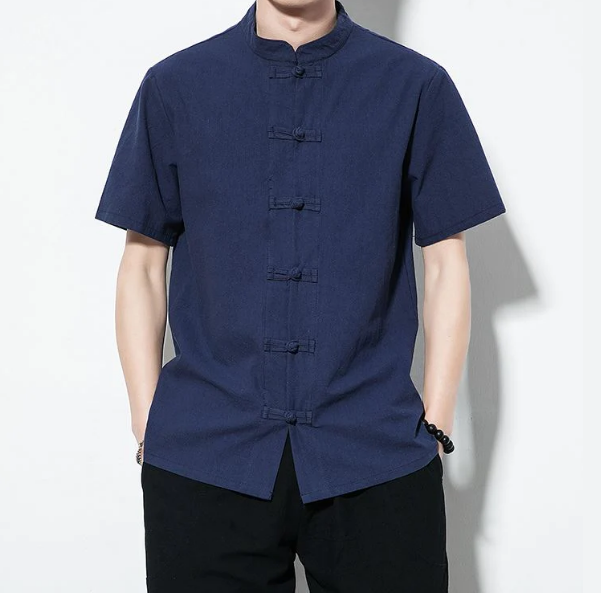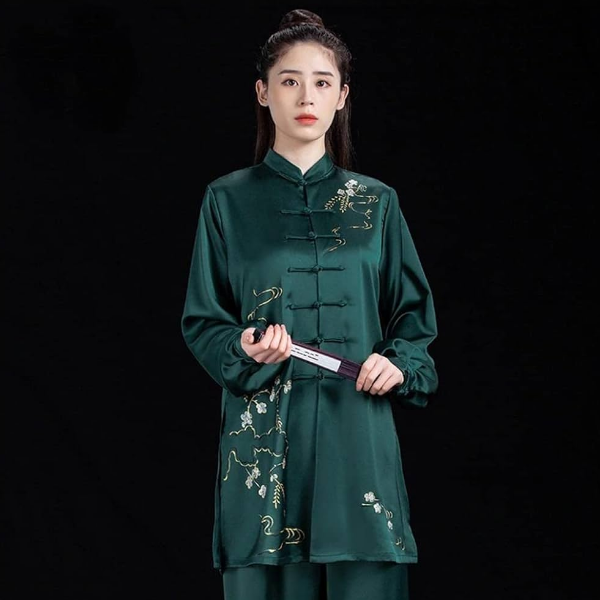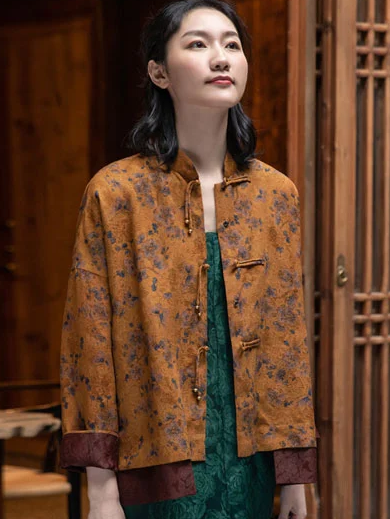Origins and Evolution
Early Beginnings
The Tang suit, often known as “Zhongshan suit”, has its roots in the Tang Dynasty, one of China’s most prosperous and influential eras. This period, lasting from 618 to 907 AD, showcased significant advancements in art, culture, and fashion. The dynasty’s influence on the suit, however, is more symbolic than direct, as the actual style of the Tang suit developed much later.
Evolution Over Centuries
Originally, the Tang suit drew inspiration from the “Magua”, a traditional Manchu jacket. It evolved significantly during the early 20th century, becoming popular among Chinese men following the Xinhai Revolution of 1911. The suit’s modern form, often mistaken for a traditional Han Chinese garment, in fact reflects a blend of Han and Manchu styles.

Sun Yat-sen’s Influence
The revolutionary leader Sun Yat-sen introduced key modifications to the Tang suit, incorporating Western-style cuts while maintaining traditional Chinese elements. His redesign aimed to unify the Chinese people with a modern yet culturally resonant attire. Sun’s version, sometimes called the “Mao suit” internationally, notably featured a turned-down collar and four pockets, representing the Four Virtues of propriety, justice, honesty, and shame.
Global Spread and Contemporary Use
The Tang suit began spreading worldwide in the late 20th and early 21st centuries, gaining recognition as a symbol of Chinese heritage. It frequently appears at traditional festivals, weddings, and formal gatherings. Modern variations exhibit a range of fabrics and styles, catering to diverse aesthetic preferences while preserving its symbolic roots.
Cultural Symbolism
Today, the Tang suit embodies a mix of traditional values and modern sensibilities. It stands not only as a fashion statement but also as a testament to China’s historical depth and evolving identity.
The suit’s story, intertwined with China’s own journey, reflects an ongoing dialogue between past and present, making it more than just an article of clothing but a carrier of deep cultural significance. Cultural Symbolism in the Tang suit thus resonates with both national pride and a sense of belonging among the Chinese diaspora.
The Historical Significance of the Tang Dynasty in Chinese Fashion
Defining the Aesthetics
The Tang Dynasty marks a peak in Chinese civilization and cultural richness, significantly influencing later fashion trends. Bold colors, luxurious fabrics, and generous, flowing garments characterized the period’s clothing, reflecting the era’s prosperity and openness. Fashion from this era stood out for its vibrant colors and exquisite embroideries, illustrating the society’s high regard for art and aesthetics.
Influence on Women’s Fashion
Women’s fashion during the Tang Dynasty particularly underscores the period’s revolutionary attitudes towards female beauty and empowerment. High-waisted skirts and flowing robes called “Ruqun” were popular, often accompanied by ornate hair accessories and delicate jewelry. These styles highlighted elegance and freedom, deviating from the restrictive norms of previous dynasties.
Men’s Attire and Its Evolution
Men’s fashion also saw significant evolution, with robes that were loose and comfortable, reflecting the Tang Dynasty’s values of practicality and simplicity. This attire, favoring wider sleeves and darker colors, offered ease of movement and a dignified appearance. The ruqun and men’s robes together demonstrate the Tang Dynasty’s contributions to the principles of balance and harmony in Chinese clothing.
Cross-Cultural Exchanges
The Tang Dynasty was a period of extensive cultural exchange, thanks to the Silk Road. This led to the introduction of new fabrics, designs, and styles into Chinese fashion, such as the use of silk, satin, and brocade. These materials were not just symbols of wealth but also of China’s connections with distant cultures, from Central Asia to the Mediterranean.
Lasting Impact
The influence of the Tang Dynasty on Chinese fashion extends far beyond its historical period. Modern designs often incorporate elements from Tang attire, showcasing its lasting impact. Designers frequently draw from the Tang Dynasty’s color palettes, fabric choices, and garment structures, bringing ancient elegance to contemporary fashion.
The legacy of Tang Dynasty fashion lives on, encapsulating a significant era of Chinese history while continuing to inspire modern fashion trends. Its historical significance remains a testament to China’s enduring cultural influence and the dynamism of its sartorial traditions. Chinese Fashion History reflects a unique blend of tradition, innovation, and cultural exchange that still resonates in today’s fashion world.
Decoding the Name: Why “Tang” in Tang Suit?
Misconceptions and Clarifications
Contrary to common belief, the Tang suit bears little resemblance to actual Tang Dynasty attire. The name, rather misleadingly, suggests a direct connection to the Tang Dynasty, known for its cultural and artistic zenith. However, the Tang suit, or “Zhongshan suit,” originated much later and reflects more modern influences.
Symbolic Association
The name “Tang” in Tang suit more likely symbolizes the Tang Dynasty’s reputation as a golden age of Chinese civilization. This period is still remembered for its artistic, literary, and cultural flourishing. Associating the suit with the Tang Dynasty may imply respect for tradition and a nod to a time of historical greatness.
Modern Evolution and Naming
The modern Tang suit developed from the traditional Chinese jacket and the Western-style suit, redesigned by Sun Yat-sen in the early 20th century. It was initially called the “Zhongshan suit,” after Sun’s Chinese name, Sun Zhongshan. The renaming to “Tang suit” in some regions might reflect a marketing strategy to enhance its appeal by connecting it to a famous and respected dynasty.
Cultural and Fashionable Context
The Tang suit today serves as a fashion item that symbolizes Chinese culture and identity. The use of “Tang” can be seen as an effort to embed traditional cultural values and pride within a contemporary garment. This naming convention strengthens the garment’s cultural significance and appeal, both domestically and internationally.
The choice of the name “Tang” in Tang suit, therefore, intertwines respect for historical legacy with modern fashion sensibilities. It embodies a cultural statement, representing not just a style of clothing but a bridge between past glory and present aspirations. Chinese Identity and Culture are deeply embedded in this sartorial symbol, making it more than just a piece of attire but a wearable expression of heritage.

The Tang Suit’s Design Elements and Cultural Symbolism
Key Design Features
The Tang suit, traditionally known as the Zhongshan suit, features a distinct straight collar and a front that either buttons up completely or partially. This design, differing from the Mandarin collar of the Changshan, provides a unique blend of Eastern and Western fashion elements. Its structure, typically with four pockets and five buttons, symbolizes the Four Cardinal Principles (Propriety, Justice, Honesty, and Shame) and the unity of the five Chinese ethnic groups, respectively.
Fabric and Color Choices
Manufacturers usually make Tang suits from silk, cotton, or wool, offering durability and comfort. Colors often hold symbolic meanings in Chinese culture; for instance, red represents luck and happiness, while black signifies solemnity and steadiness. These color choices, deeply rooted in Chinese traditions, allow wearers to express cultural values and personal sentiments.
Symbolism in Embroidery
Embroideries on Tang suits often feature dragons, phoenixes, and other motifs that carry significant cultural symbolism. The dragon, a symbol of power and authority, is a popular choice, especially for formal occasions. These designs not only enhance the suit’s aesthetic appeal but also connect the wearer to ancient Chinese myths and cultural stories.
Cultural Significance and Modern Adaptation
In contemporary times, people widely recognize the Tang suit as a symbol of Chinese national identity and cultural pride. Modern adaptations offer a range of styles, from traditional patterns to more simplified, contemporary designs, making them suitable for various occasions, from formal events to everyday wear.
The design elements and cultural symbolism of the Tang suit exemplify a harmonious blend of history, tradition, and modern fashion sensibilities. This unique combination not only makes the Tang suit a popular clothing choice but also a medium for expressing cultural identity and heritage. Traditional Chinese Clothing continues to inspire and evolve, keeping alive the legacy of past eras while staying relevant in today’s fashion world.
The Tang Suit in Modern Fashion: From Tradition to Global Trend
Revival and Reinvention
In recent years, fashion designers have increasingly incorporated the Tang suit into modern wardrobes, reinventing its traditional aesthetics for contemporary tastes. This resurgence has transformed it from a symbol of Chinese heritage into a chic, global fashion statement. They often experiment with fabrics, colors, and cuts to give the Tang suit a more contemporary feel, appealing to a broader, more fashion-forward audience.

Global Influence and Adaptation
The global appeal of the Tang suit reflects in its adoption by international designers and celebrities, transcending cultural boundaries. Some Western designers have infused elements of the Tang suit into their collections, showcasing its influence beyond its Chinese origins. This crossover signifies a growing appreciation and integration of Eastern design elements in global fashion.
Popularity in Media and Public Figures
The portrayal of Tang suits in films, TV shows, and by public figures has played a crucial role in popularizing the garment worldwide. Actors and celebrities wearing Tang suits at global events have sparked interest and admiration, highlighting the suit’s elegance and cultural richness. This visibility helps the Tang suit maintain its relevance and allure in the fast-paced world of fashion.
Challenges and Innovations
Designers face the challenge of respecting the Tang suit’s rich history while adapting it for modern use. Balancing traditional elements with innovative designs is key to creating pieces that are both authentic and appealing to today’s audience. New materials and techniques allow for more comfort and versatility, making the Tang suit suitable for various occasions, from formal events to everyday wear.
The journey of the Tang suit from a traditional Chinese garment to a staple in global fashion showcases its versatility and enduring appeal. It not only symbolizes cultural heritage but also adapts to contemporary trends, bridging past and present in the fashion world. Fashion Trends and Cultural Heritage continue to influence each other, proving that traditional attire like the Tang suit can evolve and thrive in the modern era.
Preserving Heritage: The Tang Suit’s Role in Contemporary Chinese Culture
A Symbol of Cultural Identity
In contemporary China, the Tang suit stands as a strong symbol of cultural identity and heritage. It represents the richness of Chinese history and traditional aesthetics, resonating particularly during festivals, weddings, and other ceremonial occasions. People often choose to wear Tang suits during these events to express pride in their cultural heritage and to connect with their roots.
Educational Impact
The Tang suit also plays a crucial role in educating younger generations about Chinese culture and history. Through its design, fabric, and patterns, the Tang suit tells stories of the past, offering a tangible link to traditions and historical events. This aspect makes the garment an important tool for cultural education and awareness, fostering a sense of belonging and continuity among the youth.

Influence on Global Perceptions
Internationally, the Tang suit helps shape global perceptions of Chinese culture. As a recognizable element of Chinese attire, it often appears in international events and cultural exchanges, showcasing the elegance and depth of Chinese traditional dress. This visibility promotes a broader understanding and appreciation of Chinese customs and aesthetic values.
Challenges in Preservation
One of the challenges in preserving the Tang suit lies in keeping it relevant and appealing in a rapidly modernizing society. Designers and cultural practitioners must find innovative ways to integrate traditional motifs with modern fashion trends, ensuring that the Tang suit remains a significant part of Chinese cultural attire.
The Tang suit, in its evolving forms, continues to play a vital role in preserving and showcasing Chinese heritage. It not only serves as a garment but also as a cultural ambassador, bridging generations and crossing borders. Chinese Heritage and Culture find a vivid expression through the Tang suit, emphasizing the importance of traditional attire in contemporary society.